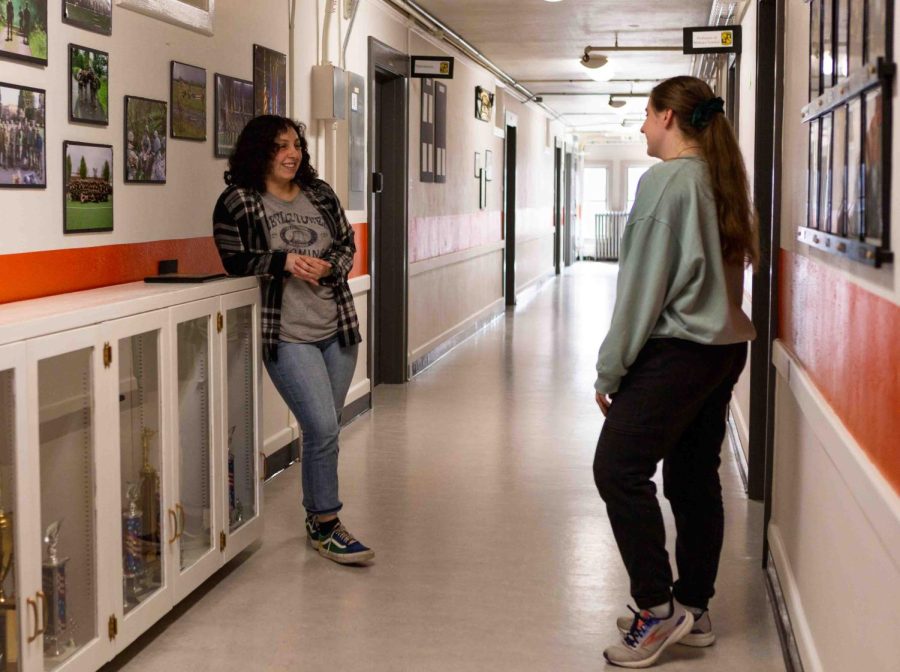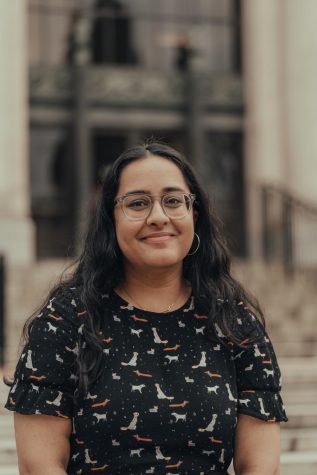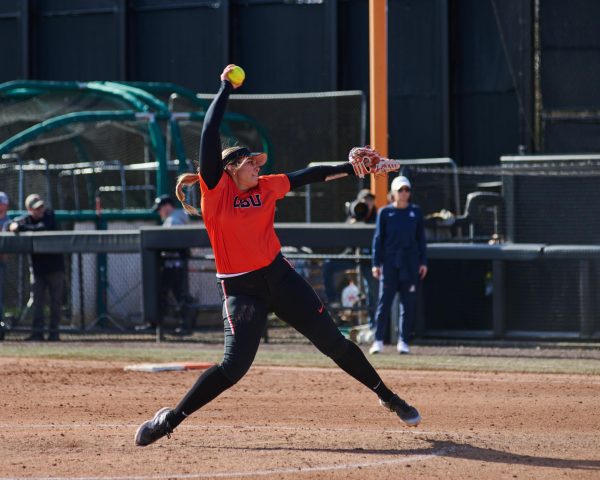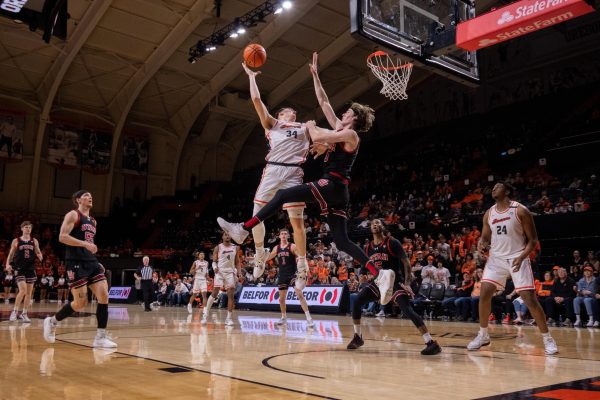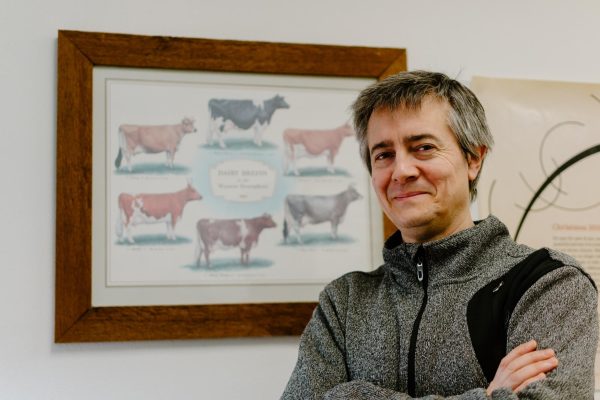Celebrate & normalize: OSU celebrates 50 years of women in AROTC program
Gabrielle Sanchez (left) and Makayla Steele chatting in the hallway on April 17, 2023 inside McAlexander Fieldhouse. They were discussing their morning run that they are required to do as part of their ROTC training as well as the upcoming 50 years of women in the ROTC celebration event.
May 1, 2023
Following Oregon State University’s Army Reserve Officers’ Training Corps 150th anniversary last year, the university will soon celebrate for another reason: 50 years of women in the AROTC program.
Hosted in the McAlexander Fieldhouse and open to all, the celebration will begin at noon on May 5. Valerie Ranum, a senior AROTC cadet planning the event, said the afternoon will feature lunch, cake and mingling.
“It’s a very special thing to be a part of, definitely shows you how far women have come,” said Makayla Steele, first-year creative writing student and first-year AROTC cadet. “We’re all equal and we all have strength, that mental strength to do anything we put our minds to.”
OSU’s Army ROTC program is one of the top 50 programs in the nation, out of 273 total programs.
“This year, the number five cadet in the entire nation is a Beaver,” said David McRae, lieutenant colonel in the U.S. Army and department chair and professor of military science at OSU AROTC. “Sophia Schmiedt is a double major in civil engineering and economics.”
AROTC is a leadership development program at OSU that develops Commissioned Officers for the U.S. Army.
“Our students, referred to as cadets, study military history, tactics, ethics and applied leadership,” McRae said. “The program takes as little as two years to complete, but many take all four years.”
ROTC is different from enlisting in the army, McRae explained, as enlisted soldiers are specialists in their craft, while officers are expected to know much of the same skills as their soldiers, but they are expected to plan, resource and lead training and combat operations.
From 1970-1972, the army conducted a pilot program at select universities, but it was only in 1973 that they opened ROTC fully to women.
“Since 1949, women could serve in the Women’s Auxiliary Corps and affiliated branches such as the Army Nurse Corps as Officers,” McRae said. “Unfortunately, I don’t fully have the history of how it came to be at OSU.”
Women were quickly incorporated into OSU’s ROTC program, and many have seen great success.
“Two of our most distinguished alumni are women,” McRae said. “Major General (Retired) Julie Bentz is a 1986 OSU graduate who culminated her career serving on the National Security Council as an advisor to the President on Nuclear Weapons. She was inducted into the OSU College of Engineering Hall of Fame and holds a Ph.D. in Nuclear Engineering. Major General (Retired) Marti Bissell recently retired after serving as the Deputy Commanding General of Army Training and Doctrine Command, responsible for the training of all Army Soldiers from Basic Training through the Army War College.”
Bentz will be the guest speaker at the 50 years of women in AROTC celebration.
“In recent years, the army has opened all branches to women, including the combat specialties,” McRae said. “Our women have embraced this challenge and we have had women branch into the Field Artillery for the last four years, including one of our Cadet Battalion Commanders (the cadet leader of program), Mia McAdams. Last year, Bailey Breving was the first woman to branch Armor in the history of the state of Oregon.”
Last year, both ROTC Cadet Battalion Commanders were women. OSU ROTC has consisted of as much as 40% women in recent years, McRae said, although the national average for ROTC is around 20%.
One of these female cadets is Gabrielle Sanchez-Hernandez, a third-year construction engineering management student who is helping to organize the 50 years of women in AROTC celebration.
“Just being together and working on something besides school brings so much more meaning; the fact that we have a goal and purpose to become officers afterwards,” said Sanchez–Hernandez of her experience at AROTC. “What I was doing today was creating this event … it just brings more meaning to my life because I’m creating something and it’ll last for a long time — first event ever, and I’ll be a part of that. That’s something not a lot of people get to say.”
For Steele ROTC has allowed her to push past her comfort zone to her fullest potential, which she thinks is important, even if people feel afraid.
“It’s scary but if you don’t do it, then you’ll never know what you’re capable of,” Steele said.
Sanchez-Hernandez said being a part of AROTC gives her confidence, not just for army life, but also for her civilian life and career outside of the army, adding that “it just makes life easier.”
“I think it is remarkable to see how routinely women lead our program,” McRae said. “We have grown from where they were rare, to where it is expected. I was once asked by a high school student if she would feel uncomfortable here as a woman in a male-dominated profession, and I told her I don’t think so. We have women in all of our key student leadership positions.”
He said he thinks this will continue to grow.
“As women become more common in the very male-dominated infantry field, we will have female cadets who choose to go this route as well,” McRae said. “We have not had one yet, but it will come soon. I think our program will continue to stay above the national average for representation and potentially approach a 50/50 mix.”
As interested high school students or current college students read about the successes of female cadets at OSU, McRae said he hopes women will come to OSU ROTC knowing they will have equal opportunities to excel.
“A common misconception is that you have to join the army to take army ROTC classes,” McRae said. “Any OSU student can take ROTC classes without any obligation and see if they like it before committing to a future career… Ninety-five percent (55 out of 58) of our contracted students are on a full-tuition scholarship.”
For Sanchez-Hernandez, it is “astonishing” that it’s only been 50 years since women have been a part of ROTC.
“While it is special, and we should celebrate it, I think we should normalize it more,” she said.
This 50-year milestone is something Sanchez-Hernandez wishes she didn’t have to think about, though.
“But the fact that I do, and the fact that I get the opportunity to do it here, it just makes it that much more special,” Sanchez-Hernandez said. “I try not to think about it too much because we’re all equal leaders, and should be thinking more of how we should be taking care of our future soldiers, (in) which (it) shouldn’t matter their gender.”
She encouraged women interested in joining AROTC, for a physical activity class or the program itself, to reach out.
“Don’t be afraid, definitely try it out,” Sanchez-Hernandez said. “There are people here to help you as well as to welcome you.”













































































































